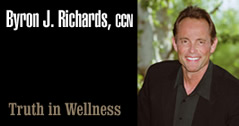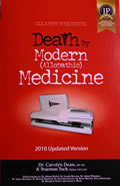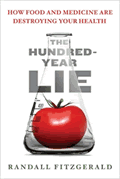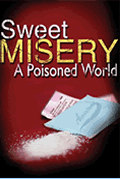WHAT'S
IN YOUR
MULTIPLE VITAMIN?
PART 2
By Byron J. Richards, CCN
May 2, 2008
NewsWithViews.com
Multiple vitamins are taken by at least 50% of American adults and 25% of teenagers. It is common knowledge that our food supply is lacking key nutrients that support health. Yet, the quality of multiple vitamins varies dramatically as the majority of the dietary supplement industry falls into the “fast food” category. Junk vitamins, like junk food, should be avoided. Educate yourself and know the difference.
In Part 1 of this two part article I explained how you can look at the minerals in a multiple vitamin or bone support product and make a good judgment about the quality of the product. In this part I will do the same for B vitamins, beta carotene, and vitamin E.
The main reason to take a multiple vitamin is to help your body make energy – as energy (ATP) is needed for anything else in your body to work properly. A good multiple vitamin should also support your mood, assist stress reduction, support immunity, and help get rid of free radicals. It should provide an array of nutrients vital to your health – covering your most fundamental nutritional needs.
What are B vitamins?
B vitamins are nutrients that cannot be synthesized in adequate amounts by your body to sustain your health – thus you must consume them. Fresh unprocessed food is an excellent source of B vitamins. B vitamins are found in many different foods including whole grains, animal meats, beans, vegetables, and fruit. Eating a varied diet of whole and unprocessed foods is the best way to get these nutrients from your food. At least half the American population is lacking adequate B vitamins for optimal health.
In dietary supplements the B vitamins are made by microbial fermentation. This is similar to the idea of friendly flora in your digestive tract fermenting your dietary carbohydrates, protein, and fiber and producing useful metabolic by-products. After the B vitamins are grown under controlled conditions they are purified, stabilized, and then ready for use in dietary supplements.
Quality variables are one issue with the B vitamins – especially how well they are purified. The entry of China into the dietary supplement raw material market has caused low-cost B vitamins to be dumped onto the consumer market. Production standards in China are not dependable at this time.
Really cheap B vitamins tend to stink a lot. Any B vitamins have a slight odor that will get stronger with age of the product. The cheap B vitamins start out in a foul smelling condition. This is why so many companies put them in tablets and then coat the tablets – trying to cut down on the smell. Open any box of B vitamin-fortified cereal and take a deep smell of the contents – you’ll see what I mean.
In addition to basic product purification the actual final form of the B vitamin that is produced makes a huge quality difference. At Wellness Resources I focus on the co-enzyme forms of B vitamins in our products as they are easy to absorb and already in the exact form your cells need – a major metabolic advantage. These types of high grade B vitamins cost much more than the inactive forms most often used in supplements, but they make a huge difference to your health.
An inactive form of a B vitamin must have energy (ATP) donated to it so as to make it useful. This process may not work well in people who are already stressed or short on energy – thus they don’t feel any better from their vitamin. In my Daily Energy Multiple Vitamin I rely on the co-enzyme forms of B vitamins.
You can readily judge the quality of a B vitamin by the form of B12 used and how much B12 is in the product. Cheap B12 is in the form of cyanacobalamin. Your body cannot actually use this nutrient in this form, thus you must first strip off the front end molecule which happens to be cyanide and then detoxify it. Then you must have the energy to turn it into one of the co-enzyme forms (methylcobalamin or adenosylcobalamin).
Why are companies putting cheap B12 in products when it makes you have to detoxify the cyanide? Answer – it is 1/10th the price of methylcobalamin. How much cyanide do you want to take? This issue takes on great importance for those with existing chemical sensitivity, chronic fatigue, or fibromyalgia.
Because B12 is almost always the most expensive ingredient in any multiple vitamin another trick is to put hardly any of it in the product. This scam is supported by the ridiculously low Daily Value for vitamin B12 set by our government to protect against anemia (6 mcg). This level of intake does not take into account the vital need for B12 in the function of your mind, health of your nerves, offsetting stress, assembly of proteins, and numerous chemistry reactions in your liver required for hundreds of enzymes systems to work properly to sustain your health.
In three capsules of Daily Energy Multiple Vitamin there are 800 mcg of the co-enzyme forms of B12 (400 mcg of methylcobalamin for your nerves and liver and 400 mcg of adenosylcobalamin to support structural protein formation).* You shouldn’t have to buy extra vitamin B12 to support your basic health – it should be in your multiple vitamin.
Natural vs. Synthetic
If there was ever massive confusion on any subject it is the issue of natural and synthetic, which means different things depending on which vitamin is under discussion.
As I mentioned previously, B vitamins used in dietary supplements are grown by a process of microbial fermentation. This is like growing food. In this sense they are all natural and from a natural source. They are then purified and stabilized by adding another molecule to them, such as hydrochloride. Such a new B vitamin molecule no longer occurs naturally in food, and so is termed synthetic. Such synthetic vitamins are generally better absorbed than food, as your body does not need to digest the vitamin out of a plant or animal fiber in order to liberate it for absorption.
Once you take a synthetic B vitamin then you further “digest it” by stripping away the stabilizing molecule and adding energy to it to change it into a fully natural co-enzyme form, and then your body uses it. People who are lacking energy may have trouble activating the synthetic forms of B vitamins.
I like to use B vitamins in their fully natural co-enzyme forms. They are easier to absorb, they don’t need energy donated to them to get them working, and they don’t have any undesirable metabolic byproducts that need detoxifying. In my experience they make a huge difference.
Here are examples of how synthetic vs. natural look on a label:
B
vitamin name -- Natural Co-Enzyme Forms -- Synthetic Forms
Thiamine (B1) -- Thiamine diphosphate -- Thiamine HCI
Riboflavin (B2) -- Riboflavin-5-phosphate -- Riboflavin HCI
Niacin (B3) -- Inositol hexanicotinate -- Niacinamide
Pantothenic acid (B5) -- Pantethine -- D-Calcium pantothenate
Pyridoxine (B6) -- Pyridoxal-5-phosphate -- Pyrodoxine HCI
Folic acid -- Folinic acid; calcium folinate -- Folic acid
Cobalamin (B12) -- Methylcobalamin; Adenosylcobalamin -- Cyanacobalamin
When you are shopping for vitamins look for the inclusion of the all natural co-enzyme forms of the B vitamins, especially on really important B vitamins like B12 and folic acid. And then look to be sure there are enough of them to actually help you with your energy and mood – which is more than the Daily Value our government sets for the prevention of blatant B vitamin deficiency diseases. Your goal is to nourish your nerves and energy-producing systems so you can function better – a difference you can actually feel!*
Natural vs. Synthetic Beta Carotene
Beta carotene is a powerful antioxidant associated with longevity and well being. Studies with beta carotene supplements are often funded by large drug companies that produce it (such as the German company BASF), and use their synthetic beta carotene. All negative studies relating to beta carotene have involved the synthetic form, never the natural form.
When we enter the world of synthetic beta carotene the word synthetic takes on a whole new meaning. In this case the beta carotene does not come from any natural process; rather, it is made by extracting benzene rings from acetylene gas and then attaching the benzene rings together to form 100% all-trans-beta-carotene.
There is no food source that contains 100% all-trans-beta-carotene. Natural beta carotene from food contains a mixture of all-trans-beta-carotene and 9-cis-beta carotene. While the trans form is the most common in your body tissues it appears to need the cis form in order to behave properly. The cis form helps produce 9-cis retinoic acid that acts as a hormone in signaling processes to normalize cell division and healthy tissue growth. Smokers taking synthetic beta carotene (lacking the cis form) were found to have an increase in lung cancer. This is far different than studies with natural beta carotene which support a protective and helpful health benefit, including to the lungs.*
You can always tell synthetic beta carotene by the label as it only says “beta carotene” and will not list a source. All products containing natural beta carotene will always list where the beta carotene comes from. The most common natural source of beta carotene is the sea algae Dunaliella salinas, which is always used in Wellness Resources products. It is a mixture of 9-cis-beta carotene as well as trans-beta-carotene along with related nutrients such as alpha-carotene, cryptoxanthin, and zeaxanthin. Natural source beta carotene contains a powerful complex of nutrients not present in synthetic beta carotene.*
The lifespan of mammalian species is directly related to the concentration of beta carotene in their blood. Both alpha and cis forms of beta carotenes are also stored in your liver, adrenals, kidneys, testes, ovaries, and fat tissues. They work synergistically with other antioxidants like vitamin E to protect your health. Only take dietary supplements containing natural beta carotene from a clearly defined food source – throw all products containing synthetic beta carotene in the trash – with any other products made by that company (as its unlikely they give two hoots about your health).
There is a large difference between what is meant by synthetic B vitamins and synthetic beta carotene. Synthetic B vitamins come from a natural source. They aren’t the highest quality forms of the B vitamins because they need energy to activate them and energy to detoxify the cyanide (in the case of synthetic B12). If your body can’t use them they are simply washed out in your urine (they are water soluble). However, they have the potential to perform normally in your metabolism. Synthetic beta carotene comes from chemicals and lacks the important cis form of beta carotene that is highly protective to body organs and cells and helps regulate healthy cell division. Your body tissues will store the synthetic beta carotene (it is fat soluble) without having the natural cis form in the tissues to ensure it behaves normally. Because it lacks the important cis form of the nutrient synthetic beta carotene should not be taken by anyone.
The Vitamin E Story
Vitamin E is under widespread fraudulent attack in the media – based on a con job perpetrated by the American Heart Association to promote dangerous drugs and negate vitamin E. This story is fully documented in my article The Statin Scam Marches On. High quality vitamin E is one of the most beneficial nutrients known to mankind – especially for older Americans who wish to bolster their immunity, memory, and cardiovascular fitness.*
The worst form of vitamin E is synthetic, and like synthetic beta carotene, it comes from chemicals not food. It is typically derived from coal tar. It is signified on the label because it always has an “l” after the “d.” Thus the synthetic form reads “dl alpha…” instead of “d alpha…” If you have any product with the “dl” form it also belongs in the trash – it is worthless.
The very best forms of vitamin E are oils and need to be placed in softgel capsules. It is not feasible to place such oils in powders that can be mixed easily in a multiple vitamin or a multiple antioxidant formulation as the vitamin E would oxidize too easily (spoil) and lose its potency. To get around this problem a molecule is attached to the vitamin E to stabilize it so it won’t spoil when exposed to oxygen. If a succinate is attached then the vitamin E becomes water soluble. If acetate is attached then the vitamin E remains fat soluble. Better quality products include other tocopherols (beta, gamma, and delta), although it is the d alpha form that is standardized for potency.
The water soluble form of vitamin E (succinate) is great for correcting an immediate vitamin E deficiency. The fat soluble form (acetate) absorbs into cell membranes where is can use its antioxidant protection for a longer period of time. It is not hard for your body to convert these forms of vitamin E into their biologically active forms by taking off the succinate or acetate. The main thing to be sure of is to never buy a product with the “dl” form – as it is from a chemical and has little antioxidant capability.*
The Finest Vitamin E
Vitamin E is one vitamin I highly recommend in a softgel form, in addition to any vitamin E that is present in your multiple vitamin or a mixed antioxidant formulation.
Most natural vitamin E on the market today comes from soy and is either 30% or 50% soy oil (you can’t tell from looking at the label). Oftentimes the other vitamin E forms (beta, gamma, and delta) are converted into alpha tocopherol by a process known as esterification. This cheapens the product as these other tocopherols also play a role in health. It is done to boost up the alpha content to get a better price. Processing methods are often hurried or careless, leading to oxidative damage of the soy oil. This means that as the product sits on a store shelf the vitamin E antioxidant is used up neutralizing the rancid soy oil. While there are a few companies that make higher quality unesterified natural vitamin E from soy, they are in the minority. Most soy-derived natural vitamin E is not top shelf.
I used to be one of the few who made true pharmaceutical grade unesterified d alpha tocopherol. One day about 10 years ago I got a call from the manufacturer who said they could no longer make this product as there wasn’t enough high grade soy to make it from (the food supply had deteriorated). Luckily, this was about the time tocotrienols came to the market.
Today the best form of natural vitamin E are called tocotrienols, a newer type of vitamin E that contains significantly more antioxidant function than regular alpha tocopherol along with other properties like naturally supporting healthy cholesterol metabolism – something alpha tocopherol does not do. I use tocotrienols from rice oryza oil and have my product made with no filler oils – thus you get a 100% pure unesterified product. Look for a product like my Daily Super E, which contains both alpha tocotrienol (antioxidant) and gamma tocotrienol (cholesterol support). Tocotrienols have ushered in the new era of vitamin E as a stellar nutrient for cardiovascular, nervous system, and immune support.*
Summary
In this two part series I have given you a comprehensive overview of basic quality information about what is in your multiple vitamin. Every individual nutrient has its own quality story. By looking at how a company puts together its main multiple vitamin, mineral, and antioxidant products you can get a very good idea of the philosophy it uses when paying for the ingredients that went into the product. This helps you to predict how that company is likely to behave on numerous quality issues that you have no real way of knowing – which typically extends to their whole product line. This is an important predictive strategy because the quality of many extracts used in other types of products is very difficult to tell by looking at a label.
Unfortunately, the dietary supplement industry is being bought up by large companies – often Big Pharma companies. The downside is that the bottom line is more important than what is actually in the products. The overall industry is hoping that you don’t understand what is actually in your products – as putting real quality into their products would turn their corporate profit margin on its head. Or if they do use real quality they don’t use enough to actually make a difference.
|
Subscribe to the NewsWithViews Daily News Alerts! |
My company, Wellness Resources, is family owned and operated since 1985. Our products evolved in a clinical setting working with thousands of people who were trying to fix and improve their health with natural methods. Often we were a place of last resort – our products simply had to work. Quality matters. I have long been at the forefront of quality in vitamin E. For part one click below.
Click here for part -----> 1,
� 2008 Truth in Wellness, LLC - All Rights Reserved















